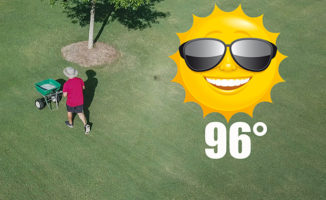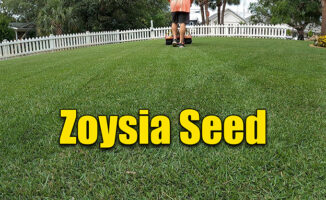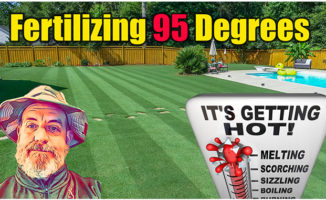Doc shows you how to spray Super Juice lawn fertilizer in the heat of the summer. He also mixes other lawn care products into the single spray.
Getting a dark green lawn in the heat of the summer can be done. Follow Doc’s tips.
Understanding Iron
First of all, what does the deficiency look like? On landscape plants, iron appears as inter-veinal necrosis (yellowing between the veins – – while the veins themselves stay green). On turf grass plants, it appears as yellow leaves starting at the top of the plant where the youngest leaves occur. It then proceeds by affecting the next youngest leaf, from the tip downwards. The lower leaves (closest to the ground) still remain green. In severe cases, the upper leaves will turn white while the lower leaves are characteristically yellow. This specific condition is sometimes seen on perennial ryegrass in the winter when the soil is very cold and wet. It occurs most on heavy textured soils (heavy clays) and on very sandy soils (which don’t hold a lot of iron).
Typical iron deficiency symptoms usually occur on ryegrass, bluegrass and fescue lawns during the beginning of spring in higher elevation areas and mid-winter in lower elevation areas. Bermudagrass shows typical iron deficiency symptoms primarily during the monsoon and in the early spring when the grass starts to grow out of dormancy.
Scalping lawns at anytime of the year often causes an iron chlorosis condition. This is because the grass is struggling to grow back from a defoliation emergency (scalping) and the roots cannot take up enough iron to keep pace with the new foliage that is growing back so quickly. This problem can be solved by simply not scalping the turf.
Iron deficiencies are often mistaken for nitrogen deficiencies in a lawn. Both deficiencies can make the lawn look yellow, but the actual leaf location where the yellowing occurs tells the story. Nitrogen deficiency causes the lower leaves to turn yellow. These are the leaves closest to the ground. Note that this is the exact opposite condition of what happens with iron deficiency. Normally, when the lower leaves are no longer useful, they slowly turn brown and wither away. When there is a severe shortage of nitrogen, the lower leaves actually turn yellow.
Applying nitrogen to a “iron deficient” lawn will make the problem worse! This is because the extra nitrogen increases growth at a time or condition when the grass already cannot extract enough iron.
Applying iron to nitrogen deficient turf will simply make the turf greener, but without much more growth. The lower leaves will still be yellow from the nitrogen deficiency. The following table reviews the basic differences between iron and nitrogen deficiencies.




